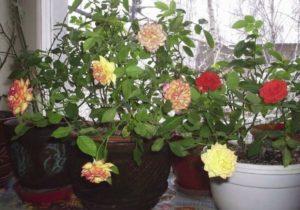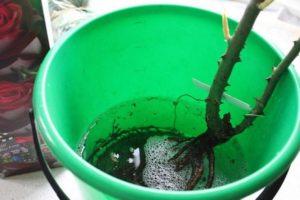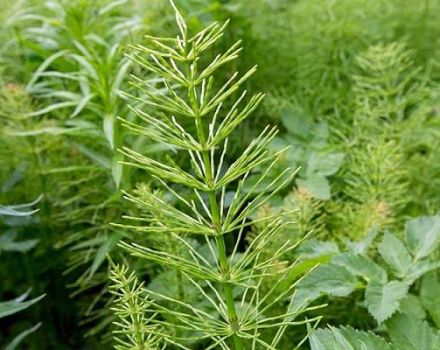Rules for planting, growing and caring for climbing roses in the open field
A climbing rose on a personal plot is beyond any competition. This flower culture, due to its high decorative characteristics and pleasant fragrance, effectively decorates any corner of the garden, creating a romantic mood and delighting with incredibly beautiful flowering. Knowing all the intricacies of planting and caring for a climbing rose in the open field, you can achieve the desired results in the form of a healthy and abundantly flowering plant.
Description of climbing rose
This luxurious plant forms perennial vines several meters long (up to 5 meters), which allows the gardener to decorate any structure on the site in a short time. The branches of a climbing rose are not only long, but also, most importantly, quite flexible. Arches, columns, trellises, building facades can be decorated in this way. The climbing rose is especially prized in landscape design.
In addition, another advantage of this flower culture is the huge range of colors. The buds can grow in diameter from 2.5 to 12 centimeters. The flowering phase of a climbing rose begins in June and lasts until the end of the warm season, depending on the variety, this period can be 30-170 days.
Conditionally climbing rose is divided into 3 groups:
- Rambler. Long vines bend well, their color is green, there are thorns. The buds exude a mild aroma, no more than 2.5 centimeters in diameter. The flowering stage begins in early summer and lasts 1 month.
- Claymers. Large buds 4 centimeters in diameter are formed on 4-meter vines. They are similar in shape to the flowers of hybrid tea roses. Flowering - double.
- Climings. This vigorous climbing rose has numerous buds that are 4-11 centimeters in diameter. They form individually or as small inflorescences. They are popular for their double flowering and high decorative qualities. Wintering is tolerated painlessly.
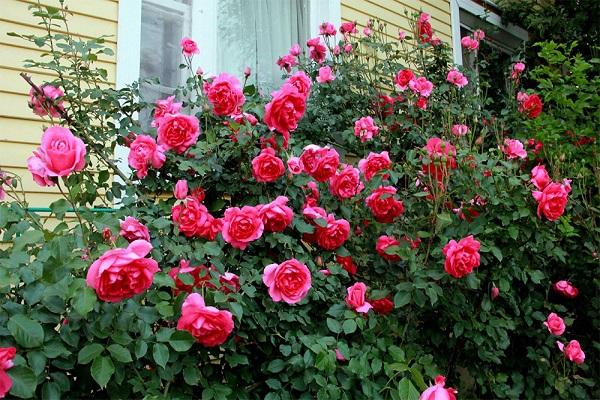
Varieties of flowers
Among the most popular varieties of climbing roses are:
- Excels. This is a fast growing plant with double flowers, which are 3-5 centimeters in diameter. The length of the shoots reaches 4 meters. The color of the buds is bright crimson. Increased frost resistance, and average disease resistance.
- Amethyst. Climbing rose blooms once a season. Shoots are 3 meters long, the thorns are large enough.Double flowers of a climbing rose of violet-pink color are collected in groups of 40 pieces, forming luxurious large inflorescences. The diameter of the buds is almost 5 centimeters. A shrub with a high level of frost resistance.
- American Pilar. The climbing rose is distinguished by its late single flowering. Ball-shaped buds are distinguished by a crimson color, but their middle is lighter with golden stamens. Climbing rose shoots are elongated, grow up to 4 meters, contain large red thorns. Closer to autumn, green leaves change their color to red.
- Blue Magenta. This extraordinarily beautiful bush forms purple-purple buds. Their diameter is 6-7 centimeters. It blooms once a season, is not afraid of cold weather, the immunity to diseases is average.
- White Flight. The flowering of a climbing rose is one-time, decorative qualities are at a high level, resistance to diseases and low temperatures is medium. The buds are pink, their diameter is 3-4 centimeters. Wavy edges are marked on the petals.

Advantages and disadvantages
Experienced gardeners distinguish among the positive characteristics of a climbing rose:
- lush and abundant flowering;
- most varieties bloom several times per season;
- large buds with a pronounced aroma;
- a sufficient level of resistance to diseases and pests;
- high degree of cold resistance;
- variety of varieties.
Among the disadvantages of climbing roses are:
- the presence of large thorns;
- burnout of buds in the sun.
Growing features
In order for a climbing rose to have a healthy and luxurious look, you need to know how to properly prepare the site for planting, and what further care measures to take.

Optimal time and place for landing
Climbing rose seedlings can be planted both in spring and autumn. In areas with a temperate climate, planting work is carried out in the last days of September and early October. And in the northern regions - in spring, when the weather is warm.
Given the photophilousness of climbing roses, it is better to choose a place for planting in a clearing that is well lit and protected from through winds, where the sun shines in the morning. Climbing rose bushes may burn in areas that are too hot. Wetlands are also not suitable, since the roots of a branchy rose can reach two meters in length and constant presence in conditions of high humidity can provoke the development of putrefactive processes on them.
Soil preparation
If there is poor soil on the site, then organic matter should be added for digging (10-20 kilograms per 1 square meter). These activities should be done in the autumn. A climbing rose will not grow on acidic soil; dolomite flour or lime at the rate of 500 grams per 1 square meter will help to normalize the environment.

If the soil is chalky, then a soil mixture from sod land, peat, taken in equal proportions, should be introduced into the hole. For two buckets of this composition, 0.5 liters of bone meal is used..
Sapling selection
When buying planting material, you should pay attention to the condition of the trunk. Its color should be white-green, but not gray or brown. Before planting, climbing rose seedlings are kept in water for 24 hours. Then the roots are cut by 15 centimeters, and the cuts are treated with chopped charcoal.
The roots are prepared in Kornevin's solution. Powerful branches are shortened by 15-20 centimeters, and weak branches are completely cut off.
Disembarkation process
The technology of planting a climbing rose in the ground provides for the following actions:
- Digging a hole in a section prepared in the fall with a depth of 60-65 centimeters and dimensions of 60 × 60 centimeters. A distance of 3 meters must be maintained between plants.
- Filling the bottom with a drainage pad (10 cm layer).
- The introduction of the nutrient composition (5 kilograms), peat compost is suitable.
- Placing a seedling in the center of the pit.
- Sprinkle soil on its straightened roots.To avoid the formation of voids, the soil is lightly tamped.
- Watering the bush with warm water (10 liters).
To make the climbing rose overwinter better, sprinkle the root collar with soil, but no more than 10-12 centimeters.

Further care of flowers
Taking care of branchy rose bushes is not so difficult if irrigation measures, loosening of the soil, feeding procedures are carried out in a timely manner and properly covered for the winter.
Watering and feeding
The optimal frequency of watering for roses is once a week in moderate dosages (10-20 liters per planting). Stagnation of moisture in the soil should not be allowed, otherwise the likelihood of developing viral ailments and loss of decorativeness is high. Young bushes, in the first year, are fertilized only at the end of summer with ash infusion.
In the second year, the climbing rose is fed with organics and mineral compounds, but in turn. And already on the third - only with organic fertilizers, for example, 1 liter of manure and 1 tablespoon of wood ash are taken for 10 liters of water. The number of procedures is 5 times; fertilizers are not used at the flowering stage.
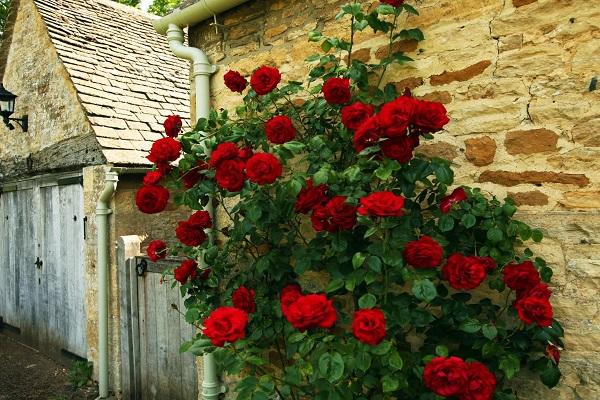
Support for climbing roses
In order for culture to be able to flow unhindered, it needs support. A tripod made of wooden beams 2.5-3 meters long, as well as an arched structure, will do. The arches look especially beautiful, on the sides of which there are planted rose bushes, the next year they will quickly entwine them.
Transfer
If the plant is uncomfortable, then through a transplant, you can correct the situation. It is best to do the manipulation in September and early October. If necessary, you can move the bush to another place in the spring. First, the climbing rose is removed from the supports, dug in a circle, stepping back 50-60 centimeters from the bush. After that, it is carefully removed from the soil and its excess is removed. The algorithm for planting a bush in a new place is the same as for a normal planting.
Loosening
To prevent oxygen starvation of the roots of the culture, it is necessary to loosen the soil after each irrigation. It is better to do this 2-3 after watering. The depth of soil cultivation is 12 centimeters. If there is a mulching layer - peat, it is periodically replaced with a new one.
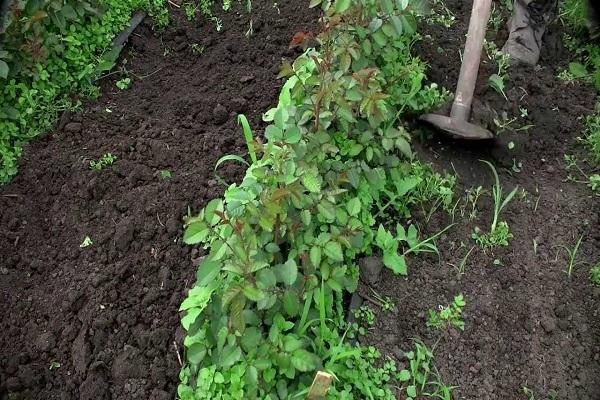
Pruning
Manipulation for the removal and shortening of shoots is carried out in spring or autumn. Incapacitated parts of the bush, including frozen shoots, are pruned. If the rose blooms once, then after the completion of the flowering phase, the branches of the second order are completely removed. Pruning climbing roses for the winter should be done with a disinfected and sharp tool.
Wintering roses
In dry weather, it is recommended to remove the vines from the supports, collect them in a bunch and tie them. When the temperature drops to -5 degrees, the shoots are bent to the ground and fixed with staples and pegs. After that, they are covered with agrofibre or film. Such a shelter for climbing roses for the winter is used in regions with severe frosts. But in areas with a warm climate, it is enough to cover it with spruce branches and wrap it with film material.
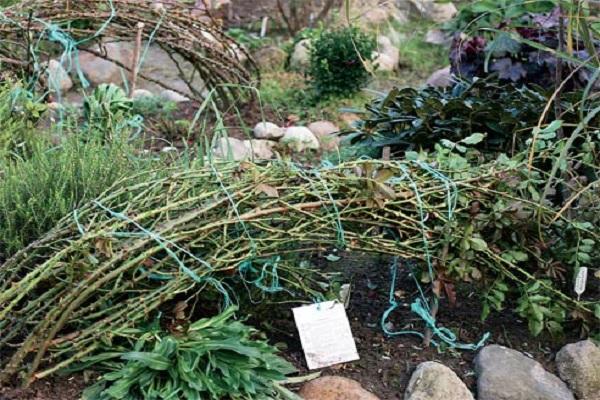
Diseases and pests
If you violate agricultural practices, then the climbing rose can overtake:
- Black spot, which is easy to identify by the emerging brown and black foci with yellow edging on the leaves of the bush, shoots. Control measures: removal of infected plant parts and the introduction of potassium and phosphate.
- Powdery mildew, which manifests itself as a whitish bloom on liana, leaf plates. In addition, the buds do not open. Control measures: the infected areas are removed, the bush is treated with iron or copper sulfate.
- Bacterial cancer, as a result of the development of which growths are formed on the roots, which leads to the drying of the plant. Control measures: the roots damaged by the disease are removed, and the rest are disinfected with copper sulfate.
It is effective to use special fungicidal preparations against spider mites, small aphids, leafworm scabbard and rose sawfly.
Reproduction
You can plant a rose garden by seed, by means of cuttings, layering and by grafting. The main thing is to know the features of each method.
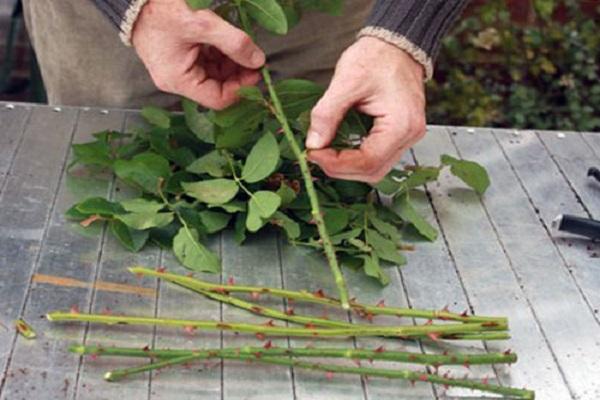
Seeds
First of all, the seed should be disinfected by keeping it in a hydrogen peroxide solution for 30 minutes. After that, you need to place the seeds between two cotton pads dipped in hydrogen peroxide, and put one sandwich in plastic bags. After signing them, you need to put them in a container and put them in the refrigerator on the vegetable shelf.
The seeds are periodically inspected, and if mold is detected, cotton pads are replaced. You can expect sprouts to appear as early as 6-8 weeks.
Sprouted seeds are planted in peat pots and perlite is placed on top of the soil, which will prevent the black leg from developing. The containers are placed in a well-lit place and, as the topsoil dries up, watering is carried out. The formation of the first buds is possible after 8 weeks after planting, and flowering - after 4-6 weeks. Landing in a permanent place is performed in the spring.

Cuttings
The most common and simple way to propagate climbing roses is by cuttings, even a beginner can handle it. Stems that have already faded and those that are still blooming are suitable as blanks. They are cut in late June and early August at an angle of 45 degrees. The lower oblique cut should be under the kidney, and the upper one should be made straight away from the kidney.
The material should have from 2 internodes. The upper leaves are shortened by half, and the lower ones are removed. The cuttings are deepened into the ground by 1 centimeter, it should consist of sand and earth or sand alone. To create a greenhouse effect, it is covered with a glass or plastic container. The stalk should not be in direct sunlight, but it should be well lit. Water it periodically.
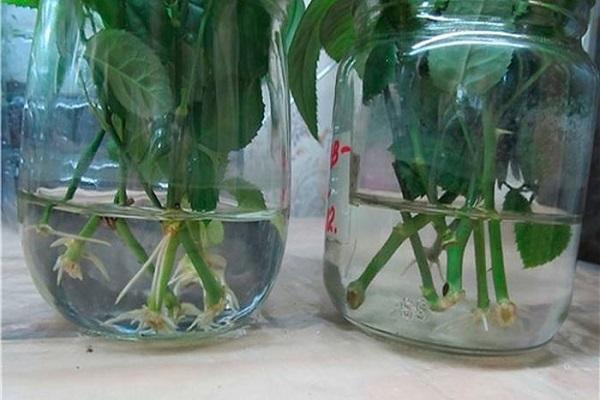
Layers
In spring, an incision of the stem should be made above the bud so that the depth and width are 10-15 centimeters. Then a layer of humus is poured into the groove and covered with soil. In this case, the escape must be securely fixed in two or three places. The main thing is that its upper part remains open. The cuttings are irrigated regularly, and the next spring are separated from the mother plant and planted in a permanent place.
Rosehip grafting
Budding is performed in late July-early August. Before the procedure, the rosehip is abundantly moisturized. After that, a T-shaped incision is made on the root collar.
At this point, the bark is carefully removed, and a peephole with a part of the bark and wood is placed in the incision, taken from the stem of the rose. Then they wrap it with budding material and spud the rosehip bush, adding soil so that the grafting zone is covered by at least 5 centimeters. After half a month, the bandage is allowed, and in the spring it is completely removed.
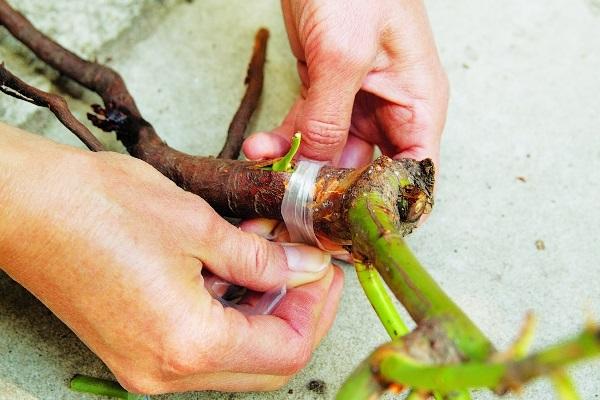
Use in landscape design
If the climbing rose is large, then it is planted in a single copy in an open area. The rose looks especially impressive in tandem with other tree plantations. Climbing rose bushes planted in a row beautifully ennoble the perimeter of the site, paths. Hedges and vertical landscaping are undeniably winning options for curly roses.
